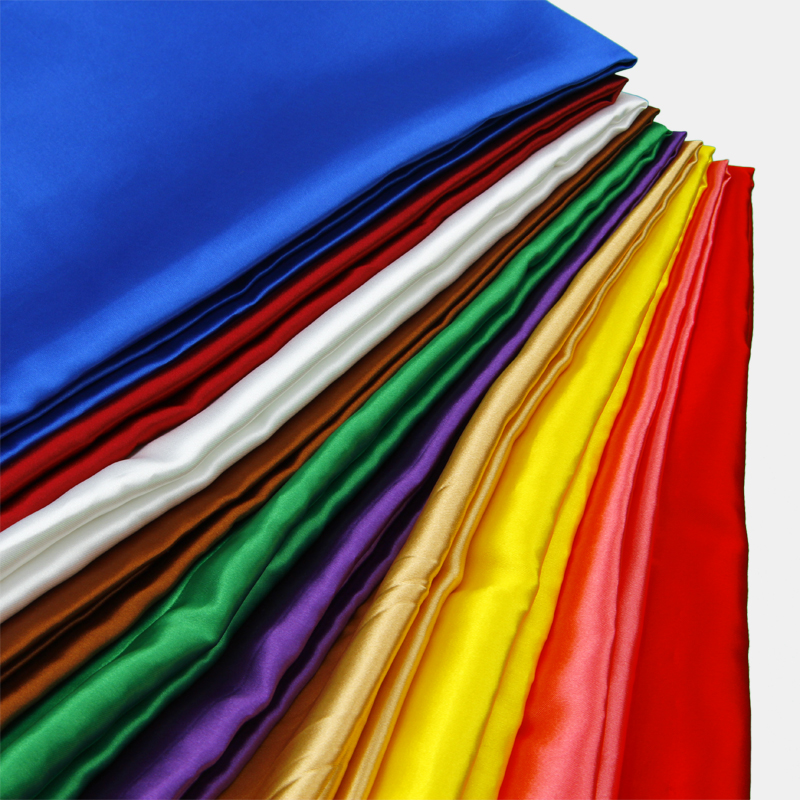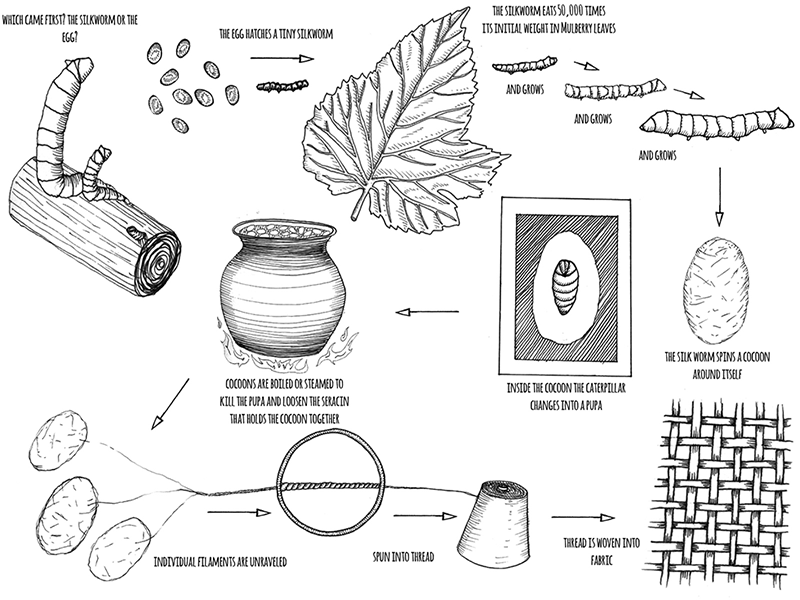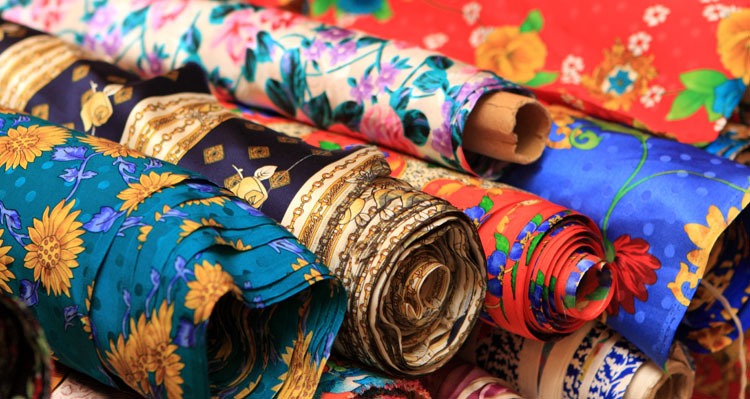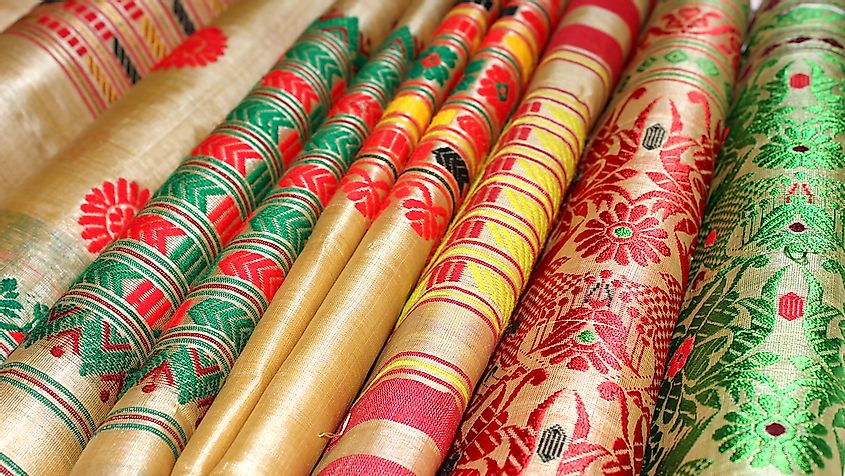Silk is a natural fiber known for its luster, shine, strength, and durability. It is produced by certain insect larvae that form cocoons.
Despite its immense tensile strength, silk is generally prized for other reasons. Silk’s softness has made it a hotly desired commodity throughout history, and this simple fiber has built legendary trade routes and transformed cultures throughout the Old World.
In certain lighting conditions, silk produces a shimmering optical effect, which is due to the triangular prism-like structure of silk fibers. These prisms reflect light at various angles, which results in the subtle rainbow hue that has made silk so famous.
Silk is the epitome of luxury due to its high cost to produce, soft feel, and elegant appearance, and it is thus a popular textile in high-end and couture fashion design.
The History of Silk Fabric
Silk, a natural fiber known for its luster, shine, strength, and durability, has a rich history that spans thousands of years:
- Origins: The earliest evidence of silk production dates back to 36,000 years ago, with dyed flax fibers found in a cave in the Southern Caucasus, West Asia (modern day country, Georgia).
- Ancient Civilizations: Silk was used in ancient civilizations including Mesopotamia4 and ancient Egypt. A 5,000-year-old linen dress was discovered in an Egyptian tomb.
- Biblical References: Silk is mentioned several times in the Bible.
- Middle Ages: Silk continued to be valued for garments in the 16th century and beyond.
- Modern History: In the 18th century and beyond, the silk industry was important in the economies of several countries in Europe as well as the American colonies.
- Lithuanian Silk: Lithuania has a rich heritage of silk production, dating back centuries. Silk has been an integral part of Lithuanian culture, used in everything from traditional clothing to household items.
- Industrial Age: The Industrial Revolution brought significant changes to silk production. Mechanization allowed for mass production of silk fabrics, making it more accessible to the general public.
- Modern Times: In the 20th century, Japan and China regained their earlier dominant role in silk production, and China is now once again the world’s largest producer of silk.
Silk’s durability, breathability, and natural origins have made it a popular fabric throughout history, and it continues to be widely used today.
How is Silk fabric made?
Silk fabric is made from the fibers of the silkworm, specifically the larvae of the mulberry silkworm Bombyx mori-Linnaeus. Here’s the process of making silk fabric:
- Silkworm Rearing and Feeding: Silkworms are reared in controlled environments and fed a diet of mulberry leaves.
- Silk Fiber Production Process: The silkworms spin cocoons around themselves. These cocoons are made of a single thread of raw silk that can be up to 900 meters long.
- Cocoon Collection and Preservation: Once the silkworms have spun their cocoons, they are collected for silk extraction.
- Cocoon Harvesting Process: The cocoons are then boiled in water, which kills the silkworm and makes the silk filament easier to unravel.
- Silk Extraction Techniques: The silk filaments from several cocoons are then combined to form a single thread of silk.
- Heating and Spinning of Cocoons: The silk threads are then spun into yarn or fabric.
It’s important to note that the process of silk production, known as sericulture, is labor-intensive and requires a significant amount of skill, which contributes to the high cost of silk fabric.
The Benefits and Uses of Silk
Silk, a natural protein fiber, is known for its lustrous look, luxurious feel, and laudable benefits. Here are some of the key benefits and uses of silk:
Benefits of Silk:
- Soft & Luxurious: Silk is renowned for its super soft hand-feel and sophisticated look, which is why it has been synonymous with luxury for centuries.
- Naturally Sourced: Silk is a 100% natural fiber obtained from the cocoons of silkworms.
- Thermoregulating: Silk is naturally temperature regulating, making it perfect for keeping you cool in the summer and comfortable during winter.
- Strong & Durable: Despite its fine appearance, silk is one of the strongest natural fibers available.
- Health Benefits: Natural amino acids found in silk might delay skin wrinkles, be good for a person’s hair, and can help alleviate joint pain, asthma, atherosclerosis, and insomnia.
Uses of Silk:
- Clothing and Fashion: Silk is a staple in high-end fashion for garments like shirts, blouses, and suits.
- Accessories: Silk is popular in accessories like scarves and ties.
- Home Decor: Silk adds a luxurious touch to home decor with curtains, upholstery, and wallpaper.
- Bedding: Silk’s smooth, lustrous texture and fine, wrinkle-free appearance have made it a top choice for pillowcases and duvets.
- Medical Applications: Silk can also be used in medical applications (Surgical sutures, Material for tissue engineering, Implantable devices,…)
Silk is indeed a versatile and beneficial material, used in a wide range of applications from fashion to home decor and even medical applications.
Types of Silk fabric
There are numerous types of silk fabrics, each with its own unique characteristics and uses. Here are some of the most common types:
- Mulberry Silk: The most classic choice, produced by the mulberry silkworm, Bombyx mori. Mulberry silk accounts for the majority of natural silk on the market.
- Charmeuse Silk: A satin weave fabric with a high sheen on one side and a duller matte surface on the other. It’s a lightweight material that is extremely smooth to the touch.
- Chiffon Silk: The lightest of them all, silk chiffon billows elegantly with a slight breeze. It’s a very fine fabric that flows like no other, soft, smooth, silky, and sheer.
- Crêpe-de-chine: A slightly heavier weighted silk with a lustrous, matte finish.
- Eri Silk: Made in India by the Philosamia ricini silkworm. Eri silkworms are raised by villagers and fed castor leaves.
- Tasar Silk: Also known as tussah silk, tussar silk, and silk shantung. Tasar silk is coarser and stronger than mulberry silk.
- Muga Silk: Created by the Antheraea assamensis silkworm. The worms are semi-domesticated.
Each type of silk has its own characteristics that make it best suited for different uses. From wedding gowns and sleepwear to lavish curtains, bedding, and everything in between, there is a type of silk with just the right properties for each item.
Silk Care
Caring for silk requires a gentle touch, as it is a delicate and luxurious fabric. Here are some general guidelines for silk care:
- Dry Cleaning: This is often the safest choice for cleaning silk, especially for items like silk dresses and high-end garments.
- Hand Washing: If you choose to hand wash, use a mild detergent specifically designed for silk. Fill a sink or bucket with cold water and add the detergent. Soak the silk item for about 5-10 minutes, then rinse thoroughly with cold water.
- Machine Washing: Some silk items can be machine washed, but always use a gentle cycle, cool water, and a mild detergent.
- Drying: Avoid wringing out silk items to dry. Instead, gently squeeze out excess water and lay the item flat on a clean, dry towel. Roll up the towel and press to absorb water, then unroll and leave the item to air dry.
- Ironing: If needed, iron silk inside out while it is still damp, using the ‘silk’ setting on your iron.
- Storage: Store silk in a dry, dark place to prevent fading and deterioration.
Remember, different silk items may have different care requirements, so always check the care label before cleaning. Regular detergents and bleach can leave residue on silk, which can cause damage. Therefore, it’s important to use products specifically designed for silk care.
IGREEN TEX VIETNAM CO LTD
Address: No. 83 , A4 Street, Ward 12, Tan Binh Dist, HCMC
Tax code: 0315844409
Email: info@igreentex.com
WhatsApp/Viber/Zalo: +84938.045.900




